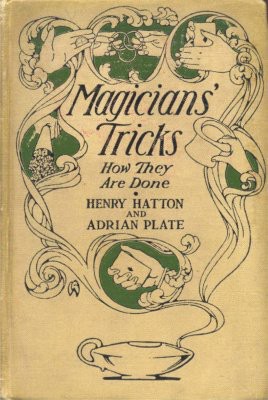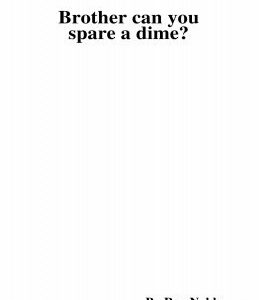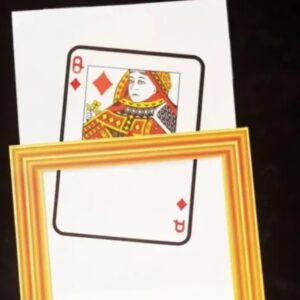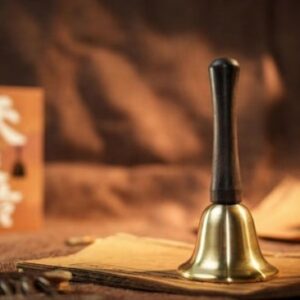This book was rated one of the ten basic books for a working library of conjuring by H. Adrian Smith, historian, collector and owner of the largest private magic library in his time. It is a magnificent book featuring tricks from Germain, Conradi, Goldston, Okito, Elliott, and others. It is very difficult to get a hardcopy these days. Other books in this top 10 list are
The Expert at the Card Table by S.W. Erdnase
The Art of Magic by T. Nelson Downs
Modern Magic by Prof. Hoffmann
More Magic by Prof. Hoffmann
Later Magic by Prof. Hoffmann
The Modern Conjurer by C. Lang Neil
Our Magic by Maskelyne and Devant
Tarbell Course by Harlan Tarbell
Greater Magic by John Northern Hilliard
Paul Fleming wrote:
In 1910, Henry Hatton, a well-known writer on magic, and Adrian Plate, an equally well-known performer, collaborated in writing Magicians' Tricks: How They Are Done. The book promptly took its place as a standard work on the subject, and could be found in the library of every up-to-date magician of that time. It is just as deserving of study today; and we are writing the present review to remind magicians of the younger generation that they will benefit by getting acquainted with this excellent but sometimes overlooked treatise.
Magicians' Tricks is a general work, covering various branches of the art of magic. Since Mr. Plate was an unusually skillful performer with cards, it is not surprising that one of the longest chapters in the book (Chapter 1, 125 pages) should deal with card magic. There are in this chapter, to start with, some 25 pages of sleights with cards, to which are later added explanations of other card sleights in connection with specific tricks. The "color-change" with cards gets a good deal of attention; so, also, do The Rising Cards (18 pages, describing the methods of Thurston, Hilliard, Hartz, de Kolta, Dr. Elliott, and others), The Cards from Pocket to Pocket (7 pages, explaining two methods, and including some common-sense patter), and A Mathematical Problem (a startling "mind reading" feat with cards); and many other card tricks are set forth in less detail. Chapter 2 (27 pages) teaches the basic sleights with coins; describes The Miser's Dream as performed by Carl Herrmann, "who introduced it into this country in 1861, and has never been surpassed in the performance of it"; explains a number of other complete coin tricks; and concludes with a 5-page explanation of a good combination trick, entitled A Coin, a Card, and a Candle. Chapter 3 (21 pages), with balls and eggs, has as its features The Patriotic Billiard Balls, in which three red, three white, and three blue balls are placed in three derby hats, so that each hat contains balls of one color only – but each of the hats is finally shown to hold a combination of red, white, and blue balls; The Egg Ching Chang (or Kling Klang) of Colonel Stodare; and The Spherical Paradox of the famous Robert Heller, a charming feat with glass balls to which the authors give 7 pages of explanation.
Chapter 4 consists of 22 pages of handkerchief tricks, the best of which are The Transit of Old Glory (a variation of The Twentieth Century Handkerchief Trick), and a combination handkerchief-and-candle trick that is explained with 7 pages of text and 6 drawings. Chapter 5 is a short (10-page) section on after-dinner tricks, of which The Lemon and Bank Note alone deserves special mention. In the final chapter (Chapter 6, 127 pages) 37 tricks are explained. Here are some of the best things in the whole book. The Disappearance of a Glass of Water, by Okito (Theo Bamberg); The Rice Bowls, with improvements by Conradi; The Spirit Table, by Karl Germain; The Nest of Boxes (10 pages), made famous by Harry Kellar and presented more recently by Dante; The Kellar Rope Tie; The Ten Ichi Thumb Tie; Kellar's Cube Root Trick; Wine and Water; Blackboard "Mind Reading" Tests; and The Egyptian Water Jars, by Germain, are among the feats explained here that have made magical history.
Magicians' Tricks is a book of 344 pages. It is unusually well written, and is illustrated with 192 line drawings. It is printed on good paper, and is attractively bound in a decorative cloth cover. It is a book that can be read with pleasure and profit by every magician.
1st edition, 1910, The Century Co., New York; later printing, 1917, The Century Co., New York; 344 pages.
I: WITH CARDS
The Pass
The Clip
The "Diagonal" or "Dovetail" Pass
The Card Palm
The Bottom Palm
The Change
The Top Change
The Bottom Change
A New Top Change
A Single Change
False Shuffles
To Leave a Prearranged Pack Undisturbed While Seeming to Shuffle It Thoroughly
Another Method of Shuffling a Pack Without Changing Its Order
To Shuffle the Pack so as Not to Disturb the Position of the Top or the Bottom Card or of Both Cards
To Force a Card
The Second Deal
The False Count
The "Ruffle"
To Spring the Cards From One Hand to the Other
The Slide
The Forcing Die
The Prearranged Pack
The Color Change
To Make a Card Disappear From a Glass
The Transformation of the Jack of Clubs
The Prediction
To Discover a Card Drawn From the Pack
A Flying Card
A Greek Cross
A Selected Card Appears at Any Desired Number From the Top of the Pack
A Card Apparently Placed at the Bottom of the Pack, Appears at the Top
A Question of Sympathy
The Card in the Pocketbook
The Disappearing Queen
The Changing Card
A Wonderful Change
With a String – A Reminiscence
The Obedient Cards
The Rising Cards in a Case
The Rising Cards, as Exhibited by Buatier de Kolta
One More Version of the Rising Cards
The Seven Heap
The Sympathetic Kings and Queens
Correcting a Mistake
Thought Anticipated
The Spots on a Freely Selected Card Will Indicate the Number of Cards Secretly Removed From the Pack
The Ace of Diamonds Changes to a Trey
The Four Aces
From Pocket to Pocket
The Vanishing Card
The Cards in the Envelopes
A Missing Card Found
A Feat of Divination
To Tell in succession all the Cards in a Shuffled Pack
To Call Out the Names of the Cards While the Pack is Behind the Back
Another Method of Discovering Every Card in a Shuffled Pack
To Call Out Cards While the Pack, With the Faces of the Cards Toward the Audience, is Pressed Against the Forehead
The Choice of a Card
The Reversed Cards
A Subtile Touch
The Sense of Touch
A Mathematical Problem
The Reunion
Dr. Elliot's Variation in the Rising Cards
To Tear a Pack of Cards in Two
II: WITH COINS
Palming
The Miser
The Peripatetic Coins
The Walking Coin
The Wandering Coins
The Disappearing Coin
How Money Attracts
To Pass Five Coins From One Tumbler to Another
The Penetrating Coin
A Coin and a String
To Pass a Coin Through a Hat
A Coin, a Card, and a Candle
III: WITH BALLS AND EGGS
To Pass an Egg From a Tumbler Into a Hat
To Pass a Billiard Ball From One Goblet to Another
The Changing Ball and Flag
Novel Effect with Billiard Balls
The Changing Billiard Balls
The Patriotic Billiard Balls
A Sperical Paradox, Not so Clear as it Seems
IV: WITH HANDKERCHIEFS
To Make a Handkerchief Disappear From the Hands
The Stretched Handkerchief
The Handkerchief with Seven Corners
The Mysterious Knots
The Transit of Old Glory
A Succession of Surprises by Le Professeur Magicus (Adolphe Blind)
The Three Handkerchiefs
A Silk Handkerchief Placed in a Cornucopia Disappears, and is Found Tied Around a Candle
V: SOME AFTER-DINNER TRICKS
An Adhesive Nut
An Elusive Ring
A Borrowed Bank Note that is Destroyed by Tearing or Burning is Found Imbedded in a Lemon
A Disappearing Knife
A Match Trick
The Moving Ears
The Talking Glass
The Suspended Glass
The Tilting Goblet
A Broken Match
VI: MISCELLANEOUS TRICKS
Paper Tearing
The Torn and Restored Strip of Paper
The Cigarette-Paper Trick
A Japanese Trick
The Disappearance of a Glass of Water, by Okito (Theo. Bamberg)
A Temperance Trick
The Chinese Rice Bowls (With Variations by Conradi)
Firing a Girl From a Cannon Into a Trunk
A Fruitful Experiment
Something From Nothing
The Adhesive Dice
The Antispiritualistic Cigarette Papers
The Spirit table (by Germain)
The Needle Trick (by Clement de Lion)
The Vanishing Glass of Water
Phantasma (by Félicien Trewey)
A Traveling Wand
A Mysterious Flight
The New Die and Hat Trick (by Will Goldston, London)
A Girl Produced From Empty Boxes (by Will Goldston)
The Nest of Boxes
A Floral Tribute
A Curious Omelet
The Coffee Trick
The Growth of Flowers
The Secret of Rope Tying
A Knotty Problem
The Knot of Mystery
The Afghan Bands
Mnemonics as Applied to Conjuring
Memorizing at One Reading a Long List of Words Suggested by the Audience
Kellar's Cube Root Trick
With Apologies to the Audience
The Clock
Wine or Water
The Blackboard Test
A Water Trick
Appendix




